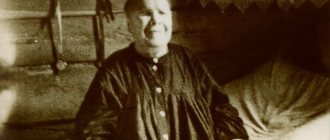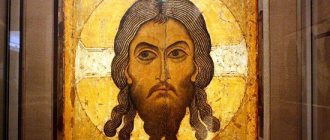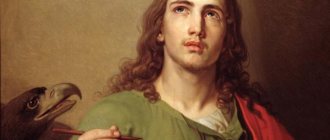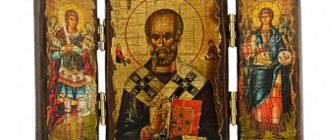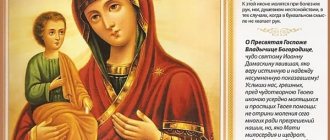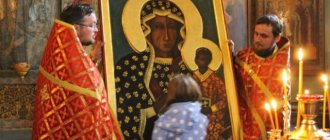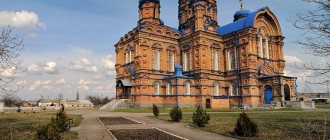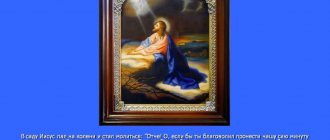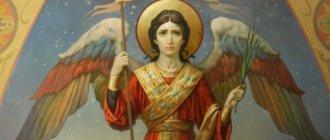Among the images of Jesus Christ created by icon painters, there is one that is unique in its own way. This is the icon “Savior of the Good Silence”, in which the Son of God appears before the viewer in the guise of an Angel of Light, that is, even before his incarnation from the Most Pure Virgin Mary and his appearance to people. According to the tradition established by the Orthodox Church, September 28 is considered the day of veneration of this image. Let's look at it in more detail.
Rare image of the Savior
The icon “Good Silence” first appeared in Rus' in the 15th century. Records have been preserved that during the reign of Grand Duke Ivan III Vasilyevich, this image was painted by a Moscow painter, whose name is not mentioned, and placed in the iconostasis of the Assumption Cathedral. For a long time it remained the only image of the Savior made in such an unusual interpretation. Let us note, however, that there is an opinion according to which the image was brought to Moscow from St. Athos, where a similar tradition of iconography had a long history.
The next mention of this icon dates back to the beginning of the 20th century, when it was painted specifically for the St. Petersburg Church of the Savior on Spilled Blood, erected in 1907 at the site of the death of Emperor Alexander II, who fell at the hands of terrorists. Somewhat later, similar images appeared in some churches in the Yaroslavl and Rostov regions.
Author
Olga Feodorovna Berggolts (1910–1975) was called the muse of besieged Leningrad. Her poems were heard almost every day on Leningrad radio; her words inspired the city’s residents and helped them fight.
Bergholz grew up in a religious family. In her diaries, she describes her state after the liturgy in the wooden church of the Kazan Icon of Our Lady: “When leaving, I took a farewell glance and thought: “It would be good if there was such a church in the soul of every person!”” She later recalled: “I very fervently believed in God, through the power of prayer, and the bright, hot delight that often overwhelmed me in church during services, I still remember.”
“Siege Poems” from the album “The Author Reads” by Bergholz
In the 1920s, the anti-religious commission became more active. Having learned about the campaign to open the relics, Olga responds to these events as follows: “We were silent and silently helped to select the holy churches, we gave it all ourselves - we, Orthodox Christians, famous for our piety! And now our kings are being dissected, scolded, and we... remain silent. What?! We will probably remain silent until we are shot. So, you’re living a great life.”
Berggolts visited Anna Andreevna Akhmatova many times. After one of these meetings, Olga makes a desperate entry in her diary: “Her collected works were “allowed for publication”,” throwing out a colossal number of poems. The words God, Mother of God are prohibited. Underlined and crossed out. How many good poems have perished!”
Olga Berggolts’s personal life was unhappy: she lost three children, her first husband was shot, and her second, literary critic Molchanov, who suffered from epilepsy, died during the siege years. In the 30s, she worked as a correspondent, editor, and published several books. But in 1938 she was falsely accused of participating in a counter-revolutionary conspiracy against the government. While under arrest, having given birth to a stillborn child, she herself almost paid with her life. Six months later, Bergholz was released. She wrote about this act in her diaries: “They took out the soul, dug into it with stinking fingers, spat on it, shit on it, then put it back and said: “live.”
During the siege years, Berggolts worked in the literary and dramatic editorial office of Radio Leningrad. She broadcast radio broadcasts almost every day, empathizing with the people of Leningrad, supporting them with poetic words, instilling in the residents faith in victory over suffering.
Chronicle of besieged Leningrad: Nurses provide assistance to victims of enemy shelling
Since Bergholz was a journalist, she had the opportunity to get out of the besieged city to Moscow in the direction of the Radio Committee. She was worried that the horror experienced by the besieged city was being hushed up behind the walls of Leningrad. Berggolts recalls about one of his Moscow business trips in 1942: “Here there is a conspiracy of silence around Leningrad, they don’t know the truth about Leningrad, it’s forbidden to speak the truth about it. Will it ever be possible to tell the truth about Leningrad, will it ever be told?
Her works often featured a prayer call. The poetess never hid the fact that she was a believer and used religious images and motifs in her poems. Thus, in her poem “Leningrad Autumn” (1942) during the siege, she writes:
Here is a woman standing with a board in her arms; her lips are gloomily closed, the board is covered in nails - as if part of a crucifix, a large fragment of a Russian cross.
Maria Berggolts, the sister of the poetess, left memories of how, on the fortieth day of Olga’s death in 1975, her husband went to submit a memorial note. They asked him: “Tell me, is this not about Olga Berggolts?” The husband replied that it was about her. Then the church employee pointed to a whole mountain of notes - all of them were for Olga Berggolts. At the service itself, Olga’s name was heard many, many times. This was how the people's love for her was expressed.
Angel with double halo
Let us dwell briefly on the artistic and compositional features of the “Good Silence” icon, a photo of which is included in our article. As mentioned above, on it Jesus Christ is represented as a bright angel, and not in human flesh, which He accepted in order to atone for original sin through suffering. It was about Him that the prophet Isaiah spoke in his prophecy regarding the coming of the Messiah to the world. This is the main feature of the image.
In addition, its distinctive feature is a double halo, consisting of a circle in which a religious symbol is inscribed - the eight-pointed “Star of Eternity”, consisting of two intersecting squares. It is generally accepted that one of them symbolizes the divinity of the Almighty, and the other - His incomprehensibility for people. At the ends of the star are often depicted Greek letters that make up the word “Existent,” that is, existing.
Before life on earth
Even before Christ came to earth, according to the Old Testament, He was symbolically called the Angel of the Great Council. The icon of the Archangel, that is, according to Christian teachings, the highest category of angels, depicts Him with wings behind his back, without a beard, a young inhabitant of Heaven. In their teachings, the Watchtower Society, better known as Jehovah's Witnesses, conveys the belief that, allegedly, before His appearance on earth, Christ was not just one of the Archangels, but bore the name of Archangel Michael, but not everyone accepts such beliefs.
Little is known about life before the birth of Jesus, this part of history is shrouded in darkness and often believers do not agree on the period “before”, but on the icon He received exactly this appearance: a baptized halo above his head, illuminated by a two-color radiance (black or blue, green means the incomprehensibility of the Lord and red signifies the divinity of the Creator), the star of Eternity, inherent in the Angel of the Great Council and Greek letters at the ends, which are a monogram of the word “Existence”. There are no other icons of Jesus with such a halo.
And although some are completely of the opinion that Jesus did not exist before birth in the form of an Angel, this cannot dispute the fact of the “life” of this image on the Good Silence icon. It depicts the Creator dressed in light clothes that shine with gold, edged with pearls and precious stones, which once again emphasizes the snow-whiteness of the fabric - the purity of the sublimity and ordinariness of noble metal and other riches, in contrast to humanity.
A few simple but expressive details
According to established tradition, the figure of the Savior is depicted dressed in a snow-white chiton, the color of which serves as a symbol of purity and innocence. At the same time, the straps (edgings of the sleeves) are perceived by believers as the bonds that tied Jesus during the unrighteous trial carried out on Him by Pontius Pilate.
The eyes of the Savior also attract the attention of the viewer. Unlike other images, where His gaze is filled with severity and sadness, in the icon “Good Silence” the angel seems to be looking inside Himself, preparing to accept everything destined for Him by God the Father. The feeling of the highest submission and humility is conveyed to the viewer by the arms crossed on the chest, as well as the wings folded behind the back.
It is characteristic that Orthodox monks see in the icon “Good Silence” a visible personification of hesychism - the spiritual practice underlying their life, consisting of tranquility, withdrawal from the world, silence, peace and liberation from carnal passions. This helps monks to get closer to angelic life while still in the flesh, and this image serves as a guiding star for them.
What does speech mean for Christians?
The modern world suffers from idle talk. Speeches are heard from everywhere that carry little useful information, but are replete with stupidity, hypocrisy, and anger.
Women living in the neighborhood gather in the evenings for gossip. People call each other to discuss rumors. The worldly press circulates useless messages: “The model showed her breasts on the beach,” “The actor filed for divorce,” and the like. Half of the texts are negative: “accident”, “catastrophe”, “rape”.
The reader plunges into this swamp - the Internet and television consume his time. Young people have been wandering along the road since the morning, their eyes glued to their gadget screens. At work, as soon as there are minutes, everyone opens social networks. Tired and sometimes irritated, a person emerges from the verbal nonsense and sees that the day is already sunset. He comes home and breaks down on the mat, hearing the reproaches of an equally overloaded relative with information...
The meaning inherent in the angelic image of the Savior
The significance of the icon, on which the Savior is represented in the image of an Angel, is unusually great, since in it His entire theological concept is revealed with extraordinary completeness and at the same time laconicism. First of all, the Savior Emmanuel appears before the viewer - the Eternal Logos, that is, that Will of God, without Which the world could not be created. In addition, He is also the sacrificial Lamb, who washed away human sins with His blood. In addition, the snow-white surplice in which Jesus is dressed indicates to the audience that this is a priest leading them to unity with the Creator.
Another important detail is the long-suffering with which the angelic face of the Savior is filled. It testifies that He is ready to wait for all earthly sinners to turn to Him, regardless of the severity of their deeds. An example of this is the Prudent Thief, crucified on the cross at the right hand of Jesus Christ and, due to the repentance brought, became the first person to gain the Kingdom of Heaven.
Historical context
The poem by Olga Fedorovna Berggolts was written in 1952. At this time, the military theme continues to occupy an important place in literature. However, the authorities called on writers to focus on the post-war problems of rebuilding the country, the world order, and expressing the ideas of development and prosperity of the Soviet Union. They were forced to remain silent about the hardships of war and post-war life, the truth of besieged Leningrad. Even May Victory Day in these years was not a major public holiday or a day off.
By 1952, the creative pathos and social optimism that the authorities expected and demanded from literature came into sharp conflict with the principles of the creativity of poets, whose lyrics predominantly reflected personal drama. Harsh critics believed that authors should never write about their experiences. The works of everyday life writers were also condemned, exposing in their texts the negative phenomena of reality and the ugliness of the Soviet order.
Anna Akhmatova and Olga Berggolts
Works that contradicted the spirit of the party were destroyed, and their creators found themselves in an environment of outright persecution. Serious accusations fell on many literary figures. Professional writers did not have the opportunity to publish their works; they were expelled from the Writers' Union and deprived of funds. Any works in which there was a separation of art and literature from the “only true” ideology were recognized as unprincipled and condemned. Not only many poets and prose writers (Grossman, Platonov, Isakovsky, Tvardovsky, Aliger, etc.), but also large magazines (Leningrad, Zvezda) came under such ruthless control. Absurd accusations and outright curses were addressed to Anna Akhmatova and Mikhail Zoshchenko. Zoshchenko was declared a “vulgar and scum of literature”, thinking criminally, in an anti-Soviet way. Akhmatova’s poetry was called “empty, unprincipled.” The poetess’s worldview was defined as alien to the people, and Akhmatova herself was called “either a harlot or a nun whose fornication is mixed with prayer.”
Zoshchenko Mikhail Mikhailovich. Photo portrait. 1934
The famous poet, student of Nikolai Gumilyov, Nikolai Tikhonov, who was once a member of the literary association “Serapion Brothers” together with Zoshchenko, was dismissed from his post as chairman of the board of the Union of Writers of the USSR. Olga Berggolts was not published because she once had close contact with the disgraced Anna Akhmatova.
The authors faced a direct threat of arrest. Under these conditions, Olga Berggolts, who could not erase the events of the war from her life and work, writes the poem “Excerpt.”
How does the “Good Silence” icon help?
It is impossible to give a monosyllabic answer to this question, since before any icon, regardless of whose image is imprinted on it - whether the saint of God, the Most Pure Virgin Mary or the Savior Himself - one can offer a variety of prayers with requests for the sending of grace to solve all earthly problems. problems. What is important is only deep faith in the omnipotence of the Creator and the sincerity of our feelings. But at the same time, a certain tradition has developed that determines the theme of petitions addressed to certain Heavenly Powers. In a certain way, this also applies to the prayers offered in front of the “Good Silence” icon.
Thus, the extraordinary humility that filled the face of the angel allows us to hope that prayers for the granting of strength and patience in the face of life’s adversities are most likely to be heard. This is especially relevant for those who are lying on their sick bed and have not given up hope for God’s help.
Humility is equally necessary for people who find themselves in one or another extreme situation. They are also recommended to seek the intercession of the Heavenly Powers, offering prayers before the bright face of the Creator Angel of all things, since it is He who, while sending down earthly blessings, at the same time allows suffering to appear in the world, cleansing and ennobling human souls.
Work
The theme of silence, its necessity, becomes one of the key ones in the work and life of Olga Berggolts. The poem “Excerpt” was written by the poetess in 1952. It is a look into the siege past. The theme of silence is the leading one. The poetess always worried that she did not have the opportunity to speak about military truth out loud.
Monument to the Muse of besieged Leningrad in St. Petersburg
The poem is extremely autobiographical and confessional. It is based on the author’s personal experiences and facts from Bergholz’s life. One day, the poetess’s mother gave her the icon “Angel of Good Silence,” which Olga kept all her life. Silent hope, resignation, which this icon symbolizes, prayer in front of this image, helped Bergholz not die during the war years. She spoke loudly in her forbidden diary, which was published only at the beginning of the 21st century. She wrote: “Today Kolya will bury these diaries of mine. Still, there is a lot of truth in them... If I survive, they will be useful to write the whole truth.”
Page from Bergholtz's diary
There are several mysterious lines in the poem: Bergholz writes that the angel of Good Silence twice turned her away from the path. It is impossible to say with certainty what the author means. But we are definitely talking about events in which Olga saw God’s Providence. It is possible that here she recalls not only her stay in besieged Leningrad, but also the pre-war repressions, when the poetess was arrested twice.
